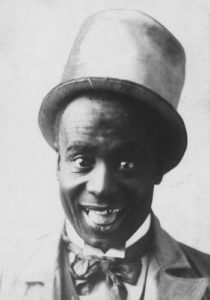
Ernest Hogan
*The birth of Ernest Hogan c1865 is celebrated on this date. He was a Black dancer, musician, comedian, actor, and producer.
He was born Ernest Reuben Crowders in the Shake Rag District of Bowling Green, Kentucky. Little is known about his childhood, but as a teenager, he traveled with a minstrel troupe called the Georgia Graduate, where he performed as a dancer, musician, and comedian. He changed his name to Hogan during this time because "Irish performers were in vogue." He would also claim that he took the name to honor Judge Hogan of Bowling Green, for whom his mother had worked as a cook. A few years after changing his name to Hogan, Ernest started finding success in solo acts in New York City.
Hogan performed in blackface, as he sometimes did later in his career. Ernest Hogan was believed to have been married twice. He was first wed to a youthful singer named Mattie Wilkes. She was a popular soprano performing in vaudeville shows with him; they married around 1901 or 1902. Hogan was later reportedly married to a woman named Louise, who helped him organize concerts in the early 1900s. The specific dates of these marriages are unknown; Hogan did not have children with either of his wives.
During this time, Hogan also created a comedy dance called the "pasmala," which consisted of a walk forward with three steps back. 1895, Hogan composed several popular songs, including "La Pas Ma La." Hogan followed this song with the hit "All Coons Look Alike to Me." Hogan was not the originator of the song's lyrics, having appropriated them after hearing a pianist in a Chicago salon playing a song titled "All Pimps Look Alike to Me." Hogan merely changed the words slightly, substituting the word "coon" for "pimp" and added a cakewalk syncopation to the music, which he had heard being played in back rooms and cafes. The song eventually sold over a million copies. Hogan's use of the racial slur "coon" in the song infuriated many blacks.
Some Black performers made a point of removing the word "coon" from the song whenever they sang it. In addition, the success of this song created many imitations, which became known as "coon songs" because of their use of extremely racist and stereotypical images of blacks. While Hogan was considered one of the most talented performers and comedians of his day, his contribution to the racist "coon song" craze haunted him. Before his death, he regretted using the racial slur in his song. The controversy over the song has, to some degree, caused Hogan to be overlooked as one of the originators of ragtime, which some called the first truly American musical genre.
Hogan's songs were among the first published ragtime songs and the first to use the term "rag" in their sheet music copy. While Hogan made no claims to having exclusively created ragtime, fellow black musician Tom Fletcher said Hogan was the "first to put on paper the kind of rhythm that non-reading musicians were playing." When the ragtime championship was held in the 1900 World Competition in New York, semifinalists played Hogan's "All Coons Look Alike to Me" to prove their skill.
He was the first black entertainer to produce and star in a Broadway show (The Oyster Man in 1907). In January 1908, Hogan collapsed onstage in New York and again in Boston while performing in "The Oyster Man." Forced to leave the show, Hogan spent the remainder of his life trying but failing to recuperate. He died from tuberculosis in Lakewood, New Jersey, on May 20, 1909.